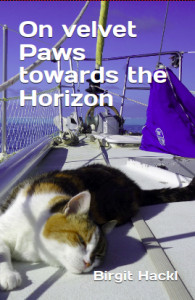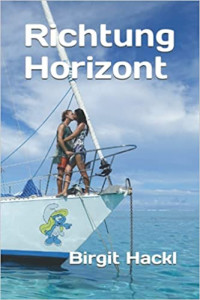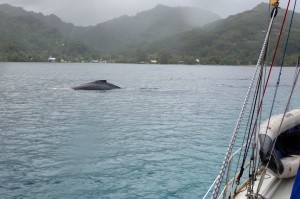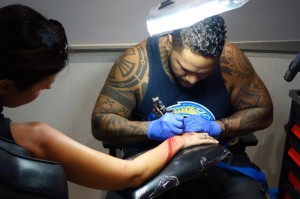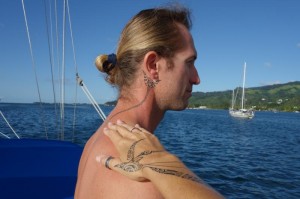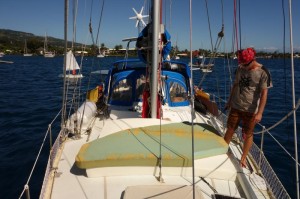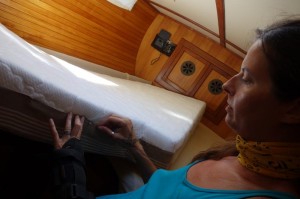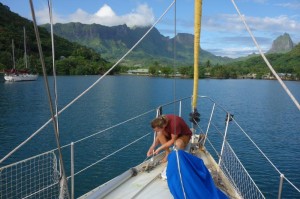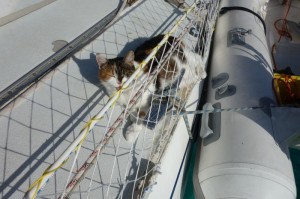We have moved to a buoy field next to the pass, close to a manta ray protection area. The big rays come there apparently every day to get some grooming from the little cleaning brigade fishies. Unfortunately visibility wasn’t great, so when we went snorkeling in that area, we could only see the outlines of the rays far below us in about 10 metres. We therefore got our scuba gear out and dived down to the bottom, trying not to lose our orientation in the murky water. After about 10 minutes of searching in circles we found a coral head where a small manta was getting some personal hygiene. He then glided away, only to reappear soon after in the company of 5 huge friends ![]()
What an experience to have 2 to 4 metre wide animals gracefully “fly” by on their black and white wings. They seem to be used to divers, inspected us curiously with their wideset eyes from only a sleevelength away.
Unfortunately the condition of the coral here in Maupiti isn’t better than in the other Society Islands and tourist boats are hustling through the protected zone. We can only hope that the mantas will continue to come to their cleaning stations in the future.
2015
24
Sep
Manta Rays
2015
24
Sep
Busy in Maupiti
We’ve only been in Maupiti for one and a half weeks, but it feels much longer, because we’ve been so active every day. We walked around the island (only about 2 hours on the one road they have), paddled the kayak up to the northern motus and to the lovely airport (no fences, no waiting hall, but a beautiful white beach and benches in the shade of trees), hiked up to the cliffs that tower over the village and after building up some fitness we finally tackled the highest mountain. The path is clearly marked and there are even ropes on the steep parts where some rock climbing is necessary. We picked a cool day with southerly winds, but we were still soaked with sweat and quite exhausted at the summit. The view over the tiny lagoon with its turquoise waters and pretty motus was absolutely worth it though.
The cover for our dinghy is also getting bigger bit by bit. We use a robust lorry canvas that is attached to the dinghy with velcro strips (sown unto the canvas and glued to the dinghy). We’ve already managed the tricky bow area where the rounded parts require tailor-made strips of canvas to make it fit tightly. The long, straight side parts will hopefully require less fiddling about ![]()
2015
19
Sep
Photos of Huahine

Huahine
Huahine's landscape is not quite as spectacular as Moorea's or Bora Bora's, but it is a pleasant island with good infrastructure and friendly locals. We spent three relaxed weeks there in August 2015.
(39 photos)
2015
14
Sep
Maupiti
Yesterday we started out early from Bora Bora and motorsailed hard on the wind in a light northwesterly. The pass of Maupiti is shallow and very narrow (about 50 m) and has a bad reputation for high surf on each side, breaking waves in the pass and strong currents. When a high swell fills the lagoon the water can only flow off through this one little opening, causing high speed currents, eddies and standing waves. At the satellite picture we downloaded beforehand it looks like a mountain stream where you’d probably consider whitewater rafting with a kayak, but certainly not with a sailing yacht…
However, we had picked the right day to go and in the calm conditions yesterday with just 1 m southerly swell it was no problem taking Pitufa through the pass against only 2 knots of current–piece of cake. After all that sweating and belly rumbling on the way we were almost disappointed ![]()
Maupiti’s a miniature paradise 25 nm west of Bora Bora. The diameter of the lagoon is only 4 nm, the high main island in the middle has 11 square kilometers (1 200 people live along the coast), and the highest mountain is just 380 m high, but looks quite rugged and impressive on the tiny island. The northern side of the lagoon is fringed by an almost continuous motu and there’s another two little motus left and and right of the pass in the south. At the moment we are on a buoy next to the pretty main village Vaiae and there aren’t many other anchoring spots as the lagoon is very shallow, but given the small distances we’ll explore by kayak, dinghy and pedes.
2015
13
Sep
Daysailing through the Societies
Most cruisers on the way west and hundreds of Tahiti/Raiatea-based charter boats visit the Leeward Islands of the Societies in daily hops sailing from Huahine to Raiatea and Tahaa (only about 20 nm), on to Bora Bora (another 15 nm) and some continue then to Maupiti (25 nm). We usually avoid daysailing as the preparations for a short ocean passage are just as time consuming as for a long one (deflating dinghy/kayak and storing them on deck, securing all the stuff on and under deck, drugging the cat so that she won’t get seasick, etc) and the effort just doesn’t seem worth it for a day. We therefore considered skipping Raiatea and Tahaa (we were there a long time last year) and Bora Bora (which has a reputation for mass tourism and private beaches/motus) altogether and to sail straight from Huahine to Maupiti. The problem with Maupiti is that it has a narrow and tricky pass facing south, which is only navigable in calm conditions without southerly swell. Sailing somewhere and h
aving calm condition’s a bit of a contradiction and during winter there’s almost constantly a swell coming from the south, so in the end we decided to split the trip into three legs just like everybody else.
On the first passage from Huahine to Raiatea on Thursday we had strong southeasterly winds on the beam, a quick, but rough ride and caught a Bonito just before sailing through the wide pass on the east side of Raiatea (despite its width quite impressive with high seas from the stern and huge breakers all along the reef). We then continued under sails through the calm waters of the lagoon up to the sister island Tahaa and spent the night in Tapuamu (where we spent a week sweating with dengue fever last year). The next day started rainy and squally, but we set out anyway and sailed goosewinged (the mainboom on one side and the foresail poled out on the other side) with gusting winds over to Bora Bora. Once again the fishing line straightened out just two miles from the pass and Christian pulled in a medium-sized yellow fin tuna. The wide pass was also easy to enter despite 2 knots of outgoing current and a howling cat sitting between the feet of the helmswoman demanding tuna sa
shimi–when she smells fish blood she goes into a feeding frenzy like a small, furry shark.
Today we’re enjoying a day in the turquoise lagoon of Bora Bora, just scrubbed the propeller in the crystal clear, calm water and later on we’ll put some jars with fish meet into the pressure cooker (sooo much easier in an anchorage…) to have preserved food for days with less luck fishing. If the swell goes down to 1 m as predicted by the forecast we’ll motorsail with light northerly winds to Maupiti tomorrow, if it remains too rough we’ll explore some more of Bora Bora.
2015
09
Sep
Whales!
From June to October humpback whales migrate to the tropics where the females give birth in the protected lagoons. We were lucky to see many of these impressive creatures from anchorages in Tahiti and even more here in Huahine. Yesterday a group of three whales (2 adults, 1 baby) came through the pass into the lagoon just off Fare and as we are anchored just on the edge of the sandy shelf next to the pass they swam past Pitufa within a few metres. There was quite some activity on the radio with crews from anchored boats alerting each other of the nature spectacle going on in our next vicinity. Everybody was watching awestruck from their decks despite a squall that arrived almost together with the whales, 2 dinghies buzzed towards them keeping a respectful distance to the giants. We couldn’t believe our eyes when a large catamaran with lots of crew steamed in through the pass and headed straight for the group of humpbacks without even slowing down. The whales dove out of sight immediately, but when they emerged again the cat went after them again and thus chased them out of the lagoon. For us it was incredible to watch such irresponsible behaviour as you’d expect at least some awareness from people cruising (or chartering) here.
2015
28
Aug
Exploring Huahine
We’ve been in Huahine for one and a half weeks and we really like it here. The pace of life is slow, only about 6000 islanders live in small villages around the twin islands Huahine Nui and Huahine Iti (big and small Huahine which are so close that they are connected by a short bridge), but the capital Fare is big enough to feature amenities like bike rental places, numerous roulottes (vans that have been turned into restaurants), a big supermarket, veggie stands with local produce and even a bar with a happy hour. There’s also a big medical centre, a dentist(!) and even a vet(!!!) on tiny Huahine. There are quite some tourists around, but most of them stay in little pensions, up to now we’ve only seen one bigger hotel with bungalows on the lagoon. There are more yachts around than we had expected, but it seems there are still puddle jumpers lingering here before heading further west and charter catamarans from Raiatea also hop over to nearby Huahine.
The first week we were anchored off the main town Fare and after the two months in Tahiti during which our only exercise was carrying shopping bags we took the opportunity of hiking to nearby temple sites (marae) and renting bikes (huffing and puffing). The anchorage on a sandy shelf between the two passes into the lagoon is pretty with turquoise water, but a constant outflowing current (because swell fills up the lagoon and the water then streams out through the passes) meant that Pitufa was always aligned with the current, even when the wind was blowing 25 knots from the side or stern, we were just swinging around then quickly being shoved back–not very comfy.
We then decided to find a more sheltered place and got the anchor up expecting a downwind sail in northeasterly winds southwards on the western coast. It seems that Huahine’s geography somehow funnels the wind over ridges though, so instead of calm conditions on the lee side we had violent gusts out of each bay and soon motored against gusts accelerated from the Southeast to up to 35 knots… Weird.
As the lagoon is generally deep with very shallow coral shelves the yacht-friendly Commune of Huahine has set mooring buoys (free use!) in several places. On the way South we checked some out, but they were exposed to strong gusts and again in a constant current. We finally found a rather sheltered spot in lovely Haapu bay off the little village. There is no current so Pitufa is properly facing into the wind again.
Mariela–the owner of the tiny magasin in Haapu–is very friendly, reserves a baguette for us each morning, offered to get us anything we need from Fare and even organised two bikes for us this morning. Unfortunately one of them broke down after a few kilometres, but Mariela played breakdown service and picked us up. Her next recommendation was a hike up the mountain ridge behind the village and she showed us the beginning of the trail, not without pointing out that she hadn’t been up there yet. Struggling up the incredibly steep and slippery path we soon understood why, but we crawled all the way up anyway and were rewarded with a great view from a rocky picnic spot ![]()
2015
16
Aug
Arrived in Huahine
The weather forecast predicted 11 to 16 knots of wind from the SE, which sounds brilliant, but then we had to motor the first 3 hours through confused seas to get out of Tahiti’s lee, then finally a breeze set in (hurrah, set the sails!), only to die down soon after. For hours the slapping genoa buffeted Pitufa with a melodic WA-WA-WHOOMM!, the fully battened main answered with a mast-shaking BAMM! and Pitufa’s crew suffered with her. Around midnight proper wind set in and pushed us through the still lumpy seas to our goal that we reached a bit delayed in the afternoon.
2015
15
Aug
… and go!
It’s only 100 nm from Papeete to Huahine, so we set out in the afternoon, to arrive tomorrow morning.
2015
13
Aug
On your mark, get set…
Finally we’ve got all our stuff together and can get ready to leave Papeete! After keeping us waiting for dinghy parts for 2 months (the rubber attachments of the mercury we bought here last year broke off after a few months and we wanted handles instead of the attached cord that had turned out to be far too weak to carry the dinghy) we got the handles we had wished for without further discussions about warranty or having to do the repairs in their shop (not very practical for cruisers to leave the dinghy there and then swim back to the boat…).
At the moment a front is passing over Tahiti, but it looks like we’ll have nice wind to sail to Huahine from tomorrow on ![]()
2015
07
Aug
Got our Polynesian Stamps
When the first explorers arrived on the Polynesian islands they were fascinated by the ‘paintings’ the locals had all over their bodies under the skin. The sailors soon got these body decorations too and the Polynesian word ‘tatau’ (or ‘tatu’ in the Marquesas) entered the European vocabulary as tattoo. The missionaries later discouraged tattoos (along with all other forms of traditional culture), but in the revival of the Polynesian culture during the last decades the old art of tatau also became popular again. Today almost all Polynesians here in Fr. Polyn. wear them proudly and after looking at this beautiful form of art for more than two years we could no longer resist and went to a popular tattoo studio here in Papeete.
Tagaloa Tattoo (check out www.tagaloatattoo.com) has a good reputation among the locals, lots of prizes from competitions decorate the walls, up to four artists work simultaneously on extensive tattoos in the traditional Tahitian and Marquesian style. We got appointments with Kalio (the boss) who asked about our lives, considered our suggested motives and then started drawing directly on the skin, altering the lines several times before adding the intricate symbols–including voyage, the sea, the sun, courage, strength, protection and loyalty. The actual needlework was then quickly done and we’re finally fully ‘papeetisised’ (that’s what boats are called here after importation…).
2015
05
Aug
Don Quijote in Tahiti
When we arrived more than two months ago in Tahiti we naively planned to get a few things done that need the infrastructure of the big city and to be off soon again. Since then we’ve been put off with delaying tactics and lame excuses. There’s a general unwillingness to take responsibility, blame others instead and of course the hope that a problem that’s ignored for long enough will disappear by itself. Whenever we have to depend on somebody else here we soon get a feeling of fighting windmills. The anchorage here in Taina has been windy and choppy for a few days–a bouncy Pitufa that keeps us from sleeping and extra splashy dinghy rides don’t help with the mood. Yesterday our mobile phone got drowned during such a dinghy ride, so we’re incommunicado for the time being.
On the positive side we’ve realised reading through the log that we’ve made steady progress on all the tasks that we can handle ourselves. While staying in Tahiti and Moorea we’ve repaired the anchor winch, found and repaired a leak in the kerosene tank, adjusted the main sail, repaired the deck light, mended the hatch covers, fixed a new railing netting, resewed part of the sprayhood, cleaned the sea strainer and the diesel filter, recut new matresses, filled up the diesel tank, bought and stored full provisioning for the next season for us and all spare parts we could think of for Pitufa, adjusted new terminals for the life lines by lathe, changed the impeller on the engine, installed new hoses for the freshwater system, got a new tap for the bathroom and redid the silcone in the bathroom–so our time here hasn’t been entirely wasted ![]()
2015
28
Jul
Just got a new mattress
When land-based people want a new mattress they just go to a shop and buy one. For cruisers like us, that’s just the first step. Then comes the explanation where the thing should be delivered to (what, you have no address, what do you mean, just come to the parking space of the yacht club?), to be repeated several times a few days later on the telephone with the astonished (lost) delivery guy (of course all in broken French).
As our bed is creatively shaped, a bit like a butterfly lying in the aft cabin with his head facing forward, we need to buy two queen sized mattresses and then cut them into shape (not to be recommended on deck on a windy day like we did). As the new mattresses are a bit higher than the old ones, we also had to alter the covers, which turned into a 3 day sewing machine project (the fact that I have my left arm in a splint to immobilise my cyst-ridden wrist for 4 weeks doesn’t help).
Step one: undo the seams of the upper part of the old cover and all seams on the new cover.
Step two: Cut the new piece according to the old part leaving a margin to make it a bit higher, sew the new upper piece onto the old cover.
Step three: Curse the crooked thing thoroughly, undo all seams and begin all over again.
Step four: Measure the new cover directly on the mattress, adjust the thing several times with pins, sew all corners (none of them at right angles) and curves by hand and then transfer it again to the sewing machine for another seam.
Step five: Celebrate, have a wonderful night on one half of the new bed and prepare mentally to repeat the whole process (minus step 2 and 3) with the second half ![]()
Good night and good luck!
2015
20
Jul
Plants overboard
We’ve been stuck in Tahiti since last week, struggling with delayed appointments, unfriendly staff at chandleries and a general feeling that the world’s not cooperating with our plans.
Somehow the herb garden under our spray hood got infected with lice and some strange, mould-like disease. My frantic efforts at cleaning the leaves and fighting the lice manually had not much effect, so with a very heavy heart I cut off a few healthy looking branches from the thai basil, the mint, the basil, the oregano and the spinach to layer, harvested everything else and dumped the plants and the soil into the sea feeling like a mother drowning her green babies.
In the evening we had Vietnamese spring rolls with handfulls of coriander, thai basil and mint wrapped in and there are still enough herbs in the fridge for a curry and pasta week.
At least we can get fresh soil from the hardware store here, the pots are thoroughly cleaned and I hope that I’ll be able to start a new garden with the saplings I’ve saved and new seeds.
2015
12
Jul
New railing netting
The last couple of days, in-between the hiking trips with more and less luck (we still have not found the track from Paopao to Vaiare…), we replaced the netting of the railing around Pitufa. Sounds easier than it actually was–in total we spent 3 full working days cutting, attaching, stretching, swearing, undoing, reattaching and tightening the bloody thing.
The old one had started to disintegrate after being exposed to the elements for more than 7 years. The new one covers only the lower half (from the middle lifeline down to the toe rail) which looks more elegant than the old full-height solution. Also, we often had to reattach the old one onto the upper lifeline due to chafing (e.g., from sheets), so this should no longer happen with the lower-half solution. Of course, there is a higher chance of loosing hats and laundry now, but it is still high enough to keep our ships cat Leeloo from slipping over board. Leeloo was suprisingly disinterested in the actual process of replacing her net, but as soon as it was finished she checked it by vigurously bumping her head into it and declared it Leeloo-safety-approved.


